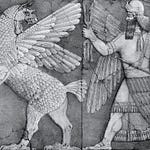This week I am once again joined by St. John’s College tutor emeritus Eva Brann. With us also is Siobhán Petersen, a fellow alum of the St. John’s Graduate Institute. Ms. Petersen is currently teaching a class on the Philosophy of AI at the Johns Hopkins Osher Lifelong Learning Institute. Together we search for the essence of the mind of the machine—its relationship to our own and to the world. Is it an analogy or analogue, image or idea, artifact or artificer? Through the gateway of Book X of Plato’s Republic, we dive into the cave beneath the cave—a world of images of images of images—that AI threatens to create to see what of truth is reflected there.
With the release of Chat GPT3 a year and half ago, the public was thrust into a new world that we (myself included) seem to understand little about. Our imaginations have been set ablaze with the possibilities of what could be accomplished with the increased power of machines that appear to be able to think and create for us. What new secrets of the universe might we unlock; what new tools and toys might we invent; in what ways might we even enhance human being; or alternatively, what new tragedies might we bring upon ourselves? The possibilities at the moment seem limitless—which, in my opinion, is always a dangerous proposition. By developing this revolutionary technology publicly, we seem to be performing a massive social experiment at scale, with little social control of how this new technology is to be implemented—and thus with little idea of what the outcome will be.
What better book to utilize, then, for delving into such a discussion than Plato’s Republic—a work, that is at least nominally, about how to create the perfect society through the proper social and political mechanisms? Although a closer reading reveals that it is in fact a warning against such attempts, there really is no greater work in the Western tradition for stimulating such questions. And of course there is the greater fact that, as in Alfred North Whitehead’s formulation, all philosophy is simply “a series of footnotes to Plato.” So why settle for pale imitations, when you can get it straight from the source? 1
***Background image created using Night Cafe AI image generator with the prompt: “Plato conducting the music of the spheres in the realm of the forms.”









Share this post